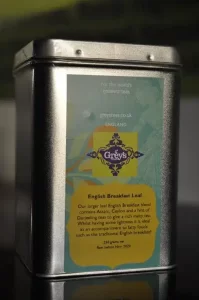Your basket is currently empty!
English Tea Blends
English Tea Blends: Explore their diversity
 English tea blends make up the majority of teas we consume in the United Kingdom. Even with all the speciality loose teas that are now increasingly popular. However, not all English blended teas are blended in England.
English tea blends make up the majority of teas we consume in the United Kingdom. Even with all the speciality loose teas that are now increasingly popular. However, not all English blended teas are blended in England.
English Tea blends each have notable characteristics derived from their constituent teas. Many of these teas have a rich heritage and the skill of the tea blender is used to ensure this character is maintained consistently from batch to batch and from year to year.
Breakfast blend is the most commonly consumed blend but the teas that make up these blends can vary widely. The majority of mass-market blends using a large proportion of teas from East Africa. Our English breakfast uses high quality large leaf Assam, Ceylon and Darjeeling teas. The latter gives a lightness not typical of breakfast blends. It is certainly not therefore one of the builder teas seen so much on the market today.
Our Good Afternoon Blend has a moreish character achieved through a small addition of lapsang souchong, a China black tea made with mature leaves smoked over a pinewood fire. Not to everyone’s taste, its limited presence in our afternoon blend adds a distinctive and very attractive touch.
Russian Caravan has a long history and is another of our popular blended teas. It originates in China yet gets its name from its long journey along the Silk Road over the Russian Steppes, traditionally by camel caravan. It contains a little oolong tea, a semi-oxidised tea from Fujian Province and Taiwan which lends it an unforgettable and moreish earthiness.
Probably the most popular blend is Earl Grey tea. This was named in honour of my four times great uncle who was British Prime Minister 1830-34 and famed for passing the Reform Bill. It contains oil of bergamot, an Italian citrus fruit. Our traditional large leaf blend comprises China Black and Darjeeling. It is a delightfully light blend with subtle, natural oil of bergamot which gives a more all-round flavour than the nature-identical flavours commonly used in other blends.
Some teas are blended and receive quite a following, although their popularity may fluctuate. Our Queen Elizabeth II Jubilee Blend is one such blend. Originally known as Queen Mary Blend it is a combination of black teas; China Keemun and Darjeeling.
For those who need a decaffeinated tea we do offer a Ceylon blend that maintains a consistent floral character, decaffeinated using the Swiss water process which results in an untainted tea. It can be drunk late, when the caffeine from full-bodied black teas might otherwise compromise sleep.
Tea blends can include those that have been flavoured such as Blackcurrant. Other traditionally flavoured teas can be black, such as Rose Congou containing rose petals or even the beautifully smoky or even tarry Lapsang Souchongs, a tradition of China’s Fujian Province. China has a proud history of producing flavoured green teas which absorb aromas particularly well. These include Magnolia and Vanilla. Jasmine containing fresh jasmine flowers are also a famous product of Fujian Province. Visually jasmine teas can appear deceptive for most of the flowers are removed prior to packing.
Indian Masala Chai is becoming increasingly admired. It is a traditional northern Indian tea containing a mix of spices such as cinnamon, cloves and cardamom. Some blends even contain ginger. Whilst a very attractive beverage can be made from simply infusing the blend it is traditionally boiled with milk and sugar for around two minutes.
English tea blends do offer a myriad of taste experiences which of course you can add to yourself by blending your favourite teas at home. If you like one particular aspect of their flavour then this can prompt you to explore the single-origin teas such as Assam, Darjeeling, China Keemun, Ceylon Dimbula or Kenyan teas. It can open up a world of discovery!
See our website catalogue section for English Blended Teas.
